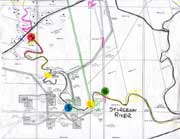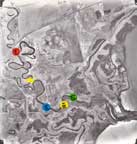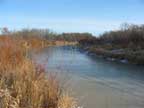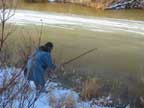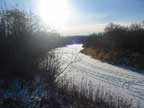Late on New Year’s Day of 2003, it was reported that the Sturgeon River ice west of Big Lake near St. Albert was melting rapidly. At the time, the temperature was at least -15C at night, and the river was not open anywhere else. This was a major melt which, within a few days, fanned out 500m into Big Lake, before freezing over again. This was not just some frozen seepage along the banks. Three distinctly separate areas of the river were affected. They are all located within the oil/gas field that has been in production since the 1950s. Gas and oil pipelines crisscross the entire Sturgeon River delta. (see maps)
Alberta Environment was notified that same night. Several local residents representing the Big Lake Environment Support Society (BLESS), the official provincial stewards of the Big Lake Special Places 2000 area, walked the entire length of the river from the Meadowview Sturgeon Bridge east to Big Lake. They confirmed the melting conditions and reported that the yellowish/brown substance on the river tasted very salty. (see see ground photos)
An aerial survey (see photos) clearly showed the three distinct discharge areas. They were designated site I, II, and III, from the west, downstream to the east (Big Lake).
Federal and Provincial Regulatory Agencies inspected the site and took water and ice samples at sites II, II/III (between II and III) and III between January 7 and 13, 2003. The lab results indicated an unusual high pH level of 9.5 at site II/III (upstream background sample 7.5) and high salt and bicarbonate levels, as well as rather unexpectedly high barium levels. The imbalance between anions and cations also remains unexplainable.
Toxicity testing on daphnia magna and baby trout was acutely lethal: mortality rate 100%.
Active drilling was going on close to the river about that time. One well had blown and had to be “killed” three weeks before the discharge onto the river was discovered.
Alberta Environment and Environment Canada investigation concluded that: “the materials are naturally occurring and not a result of oil activity in the area.” The discharge is attributed to freeze-out – seepage of concentrated river water from river banks. Reasons given:
- no hydrocarbons were found in the substance or in the water;
- the substance does not have the same characteristics as process water from oil and gas activity;
- the substance does have the same characteristic as groundwater in the area.
Site I, the most extensive of the discharge sites, see photo) was never tested. It was assumed that the results would be similar to those of site II and II, since it was erroneously believed that site I was located downstream of the other sites. Warm weather melted the “evidence” before samples additional could be obtained.
It has now been more than 3 months since the incident was reported. An acceptable explanation as to the source of the substance has not yet been provided. It appears that a mysterious discharge made its way from somewhere onto the surface of the ice: the water underneath the ice did not show the same contamination.
It seems that something was not expected to be found in the samples and thus was not tested for in the routine water analyses: you only find what you look for.
Dynamic Gas and Oil, the company which owns the oil and gas fields, conducted their own tests of an area of the river. It was not one of the sites that showed the melting river during the aerial and ground surveys. The site they sampled was frozen at that time. (See photo) Their test results are typical of what would be expected of “freeze-out” on the river, which is something that occurs frequently.
P.S.
A complete blow-out report for the well that had blown early in December and had to be killed has not been released; the media information mentions that “treated fresh water” was used to kill the well. The chemicals used to treat the water have not been made public. “The EUB applied a Major Level 2 enforcement action against Dynamic Oil and Gas for contravention of certain EUB requirements — specifically in regard to the following non-compliance items:
- – BOP stack – proper size pipe preventers were not installed;
- tripping procedures – pipe light calculations were not being conducted.” There are several steps Dynamic will have to take in future to prevent similar incidents, including providing on-site personnel and engineering support.
Dynamic has withdrawn, temporarily, an application for an additional sour oil well, and scheduled public hearings on the application have been cancelled.
Photos of Site I
click images to zoom
Photos of Site II/III and III
Map of Oil and Gas Wells in the Area
Aerial Photo of the Discharge Areas
Areas Where the River Melted in January
Section of the River Between Discharge Sites
Dynamic Oil and Gas Test Site






